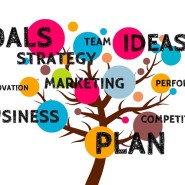Business Development

Successful business development involves new business formation, company acquisitions, the development of new product lines, and the business re-engineering of existing organizations to better align themselves to changing market demands and product life cycles. Every business must continually adapt to grow and succeed.
It is not enough to have a great idea or the best product. First and foremost, you need a sufficient number of customers who want to buy and make it worthwhile for you to make it. You need that team of people that will help you turn that idea into a product, and then make it the best that it can be. You need another group of people to help you find that most critical of resources, new prospects and customers. Another group will help your customers fully utilize the product throughout its life. And, other groups to create and maintain business relationships to build, test, install, service, distribute, market and sell it through all of the possible sales channels and in all of the geographical areas.
There are many critical areas to your success. They need periodic review and adjustment to meet changing market conditions.
Messaging – Prospecting, Selling & Closing
You get into the elevator and your key, qualified prospect that you’ve been trying to reach for weeks is there. What are you going to say? You finally reach the key decision maker, how are you going to persuade him to listen to you, much less make the decision in your favor? You’re sending a mailer to potential prospects, how are you going to get them to contact you?
In all cases, you are trying to capture an audiences attention with a collection of words. Your are competing with many others for their attention. You have at best 15 seconds to get their interest or to appeal to their curiosity. You can get their attention either by your presentation, its content , or both.
But, you have only just begun. After you have captured that initial interest, you have another 15 to 45 seconds to engage them. You have to say something that THEY are interested in or have a need for. That’s one of the important, but often missed differences between a qualified and unqualified prospect.
Each step and type of audience requires a slightly different message and presentation. How is your messaging? Are you achieving the results that you think you should be getting?
Sales / Market Coverage Analysis
Do you know who you best customers are, and what/why they are purchasing your products? Are you missing opportunities to sell them additional products? Do you know what your market potential is? Are your sales and marketing teams properly aligned to maximize your market penetration and overall sales? Are you missing sales opportunities? Are you pursuing unprofitable sales.
Sales and market coverage analysis examines how you are selling and applying your direct and indirect sales force(s) to your market on an industry and geographical basis. The analysis identifies how you can quickly increase your sales, decrease your costs, and better retain those key customers by better aligning your key resources to your market.
Closed Loop Lead Management / Prospecting
With a new product, expanding market, or low market penetration, how do you find, educate, sell, cross-sell and/or up-sell new and existing customers? How much does it cost to acquire each new customer, and is it the most effective use of your limited resources? What type of marketing campaign will yield the best results?
To reliably and cost effectively acquire new customers requires a closed loop lead management business process with knowledgeable, enthusiastic, and hard-working personnel and a reasonable sales/marketing budget. To be effective, this process generates status reports at key points that enables the different market and sales programs and campaigns and their associated processes to be continually adjusted to meet changing market conditions.
A channel is the organization and/or method that you use to market, sell and service your products and services. Channels include: field sales, field service, telephone sales, telephone service, distributors, retail outlets, partners, Internet, TV, radio, print media, etc.
Different channels reach different audiences. For example, TV advertising reaches prospects and customers that regularly watch TV. Internet sales and service reach people that have a computer and surf the Internet. Target audiences can also be segmented by age, geography, experiences, buying history and power, job position, interests, etc.
Not all products can be sold through all channels. A custom suit of clothes that is tailored to the individual, cannot currently be sold through the Internet. The buyer needs to visit a store where he is measured and fitted. Please note that the word “currently”. Product/channel alignment changes as new technology is introduced (e.g., a camera that can automatically take measurements), products are made channel-ready and channel-friendly (e.g., the clothes automatically fit themselves the wearer), and the prospect/buyer has access to the channel and is comfortable in using the channel to make his purchases.
Different channels have different costs. A field sales force is very expensive. A telephone sales force is substantially cheaper. And, an Internet facing sales force is almost free. But, not all products can be sold through all channels, and not all customers will do business through them either.
What is your channel/product alignment? Are you achieving your desired sales results through each channel? Are your channels working synergistically together, maximizing your sales and minimizing your costs, or are they working independently? How is your channel conflict? Are you losing sleep over endless complaints?
Partner Programs – Assessment & Development
Everyone wants to have a partner program. Through these programs, you will supposedly either increase sales, gain access to new technology, products and/or services, increase your market coverage, and/or secure a service/capability which your company needs. Partner programs come in all different forms. Some are formal, while others are not. They exist in all different areas of the company, from sales and marketing, through manufacturing and service.
The only partner programs that have any success and longevity are those where both parties equally benefit. Make the benefit less equal, the shorter the program will last. Unfortunately, partner programs can be expensive. While it is easy to measure those expenses, sometimes it is very difficult to measure the benefits (intangible versus tangible).
What are your programs? Do they have objectives and are they being met? Can the programs be improved, or should they be discontinued? What do your partners think?
What do you need to be successful? Are your organized for success? Are your personnel productive? Are your business processes helping you achieve your objectives, or slowly you down? Do you have adequate visibility into your observations? When opportunities and problems occur, do you have sufficient time so properly resolve them. Is your technology friend or foe? Are your prepared to handle those unforeseen situations?
A Needs Assessment simply determines how you are doing. It identifies those things that you are doing well, and those areas where improvement could be made. It can even provide an ROI justification for the acquisition of some critical personnel, process and/or technology.
Every program should have a positive contribution to an organization’s bottom line. Not all do.
While a Needs Assessments examines an organization and its operations, a Program Review assesses how well a formal program is performing across multiple organizations. It determines how well a program is meeting its objectives, and it identifies those areas that could be improved, and at what cost.
What is the best method for achieving a specific objective?
Modeling enables you to experiment without disrupting your current operations. It enables you to evaluate different methods and solutions to different problems and opportunities. You can evaluate the various what-if scenarios, and assess the potential results.
Anything can be modeled as long as sufficient information is being collected. Before the proliferation of computers throughout companies, it was difficult and expensive to collect and assemble this information. Now there are spreadsheets, statistics and sophisticated enterprise software programs that are spewing data and information daily.
The trick is to identify what the key metrics are from an organization’s key business processes, and then collect, catalog and assimilate them. The analysis is relatively easy. It only requires experienced personnel to interpret the results.
Through financial modeling and planning, you can find significant business improvements.
Share this:
Recent Comments